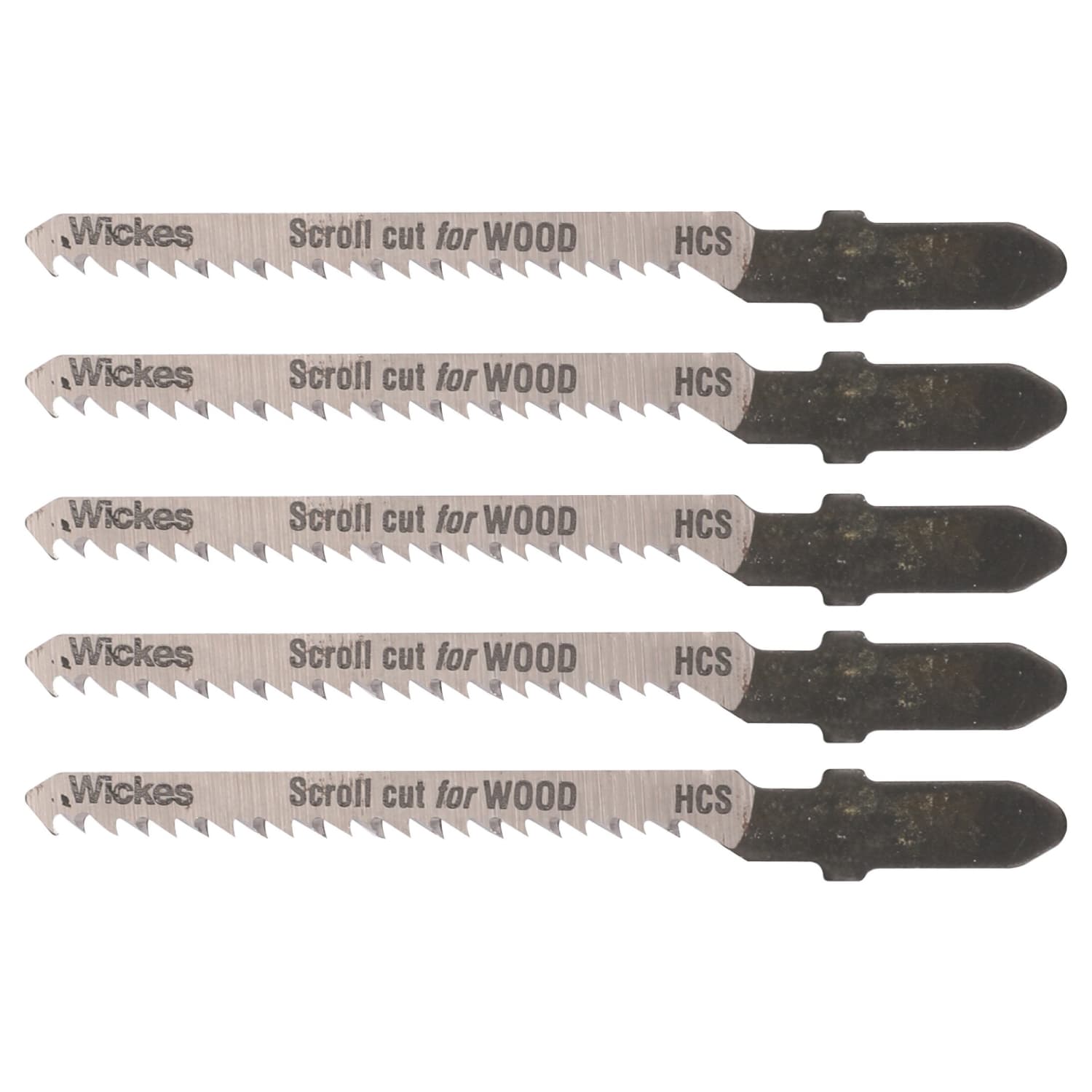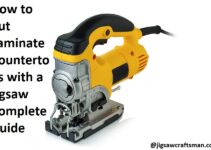Are you looking for the best jigsaw blade for your woodworking projects? Look no further.
In this comprehensive guide, you’ll learn all about jigsaw blades. Discover the different types, materials, and applications of saw blades and find the right one to suit your needs.
In this guide, we will discuss the types, materials, and applications of jigsaw blades. A jigsaw is a versatile power tool used to cut a variety of materials such as wood, metal, and plastic. To help you make the most of your jigsaw work, it’s important to understand the types of blades available and how they impact the cutting results. Each blade type has its own strengths and features that should be considered when selecting a blade for your application.
We’ll also discuss which materials are best suited for which blade type in order to help you maximize your potential when using a jigsaw. Additionally, examples of common applications that pair up with different material and blade combinations will be explored in this guide. After reading this guide you should have enough information to choose an appropriate blade for any given job situation.
Definition of Jigsaw Blades
Jigsaw blades refer to a type of saw blade specifically designed for use in a jigsaw – a power hand tool used to cut curved and irregular shapes in wood, plastic, metal or other material. Jigsaw blades are available in various sizes, shapes and materials so they can cut different types of materials.
Jigsaw blades come in both T-shank and U-shank styles to fit various types of jigsaws. There are also several different types of teeth used on the blades, depending on the material that is being cut.
When looking for the right blade for a job, it is important to consider not only the type and shape of teeth but also the thickness, length and construction material of the blade itself. This guide will explain what factors need to be taken into consideration when selecting a jigsaw blade for any project.

Importance of Jigsaw Blades
Jigsaw blades are an essential component of all jigsaws, and having the right blades for the job can make a big difference when it comes to achieving the best results. Depending on what type of material you are trying to cut, different jigsaw blades offer different levels of resistance and accuracy. Different materials also require different blades, so it is important to select the right blade for your project’s specific needs.
Additionally, choosing the right blade can help reduce wear on your jigsaw and extend its working life. When selecting a blade, there are several factors to consider including blade type, blade material, tooth count and shape. Each of these components affects how well your jigsaw performs in cutting a particular material. It is important to understand how each factor works in order for you to select the most suitable blade for your needs.
Materials Used in Jigsaw Blades]
When it comes to choosing the best jigsaw blade for the job, materials make a world of difference. To ensure that your project is successful, you need to be sure that you have chosen the right type of blades for the material you are working with. Below are a few common materials used in jigsaw blades and how they can be used in various cutting tasks:
High Carbon Steel: This is one of the most popular materials used for jigsaw blades because it is exceptionally strong and has good wear resistance. It is most common among woodworking applications, but can also work well on other materials such as plastic, aluminum, and brass. It is not suitable for cutting hard metals like stainless steel.
High Speed Steel (HSS): HSS blades are widely used for cutting hard metals like stainless steel as well as plastics and other soft materials. They have exceptional wear resistance and heat-resistance so they don’t overheat during long tasks. They have less flex memory than carbon steel blades so they won’t deform or warp when making long cuts.
Bi-Metal Heavy Duty Blades: These high performance blades are made from two layers of metal which increases durability while providing a flexible body resistant to breakage or chipping during continuous use in difficult applications such as metalwork and stone carving jobs. Bi-metal heavy duty blades tend to hold an edge better than single layer HSS or carbon steel blades and can cut through harder materials with ease.
Tungsten Carbide Tips: Tungsten Carbide (TC) tipped blade tips offer exceptional performance when cutting hardwoods, metal alloys, copper, aluminum extrusions, laminates due to their exceptional hardness rating – up to five times harder than standard high speed steel!! The tips are also highly resistant to abrasion allowing them to stay sharp longer make them ideal for heavy usage where blade life is essential.
High-Speed Steel (HSS)
High-speed steel (HSS) is the most common type of jigsaw blades. It was developed in the early 1900s and is well-known for its strength and durability.
This type of material is made up of tungsten, chromium, vanadium, and cobalt alloys, and gives the blade greater hardness that prevents it from dulling quickly when cutting through tough materials like wood. HSS blades are also heat resistant and can be used in damp and wet conditions as they do not corrode or rust easily.
HSS blades can be used to cut through a variety of materials such as plastic, soft metals, plywood, hardwood, MDF boards and more. The different types of HSS jigsaw blades are available in various sizes ranging from T-shank to U-shank designs depending on your jigsaw model.
Carbon Steel
Carbon steel jigsaw blades are made from an alloy of iron and less than 2% carbon, as well as other elements such as manganese, sulfur and silicon. This type of blade is extremely tough, often being used for heavy-duty applications in woodworking. Carbon steel’s hardness makes it excellent for cutting through hard woods and metals, but the material is also more brittle and difficult to sharpen than other blade materials.
Carbon steel jigsaw blades are well suited for thicker materials like dense hardwoods (ie: oak or walnut). They can be used to make quick work of cutting through nails or screws embedded within a workpiece. Be aware that they may leave a dull finish, however due to their tendency to generate heat while cutting. When used on softer woods such as pine or plywood, carbon steel blades can leave behind a smooth finish but with some visible tear-out along the edges.
Bi-Metal
Bi-Metal jigsaw blades are some of the most common and versatile blades on the market. They are constructed with a hardened high-speed steel (HSS) body and teeth welded onto a softer spring steel back. The combination of these two materials creates a durable and long lasting blade that withstands even the toughest materials.
Bi-metal jigsaw blades can cut through a wide variety of materials, including wood, galvanized metal, casting metals, aluminum alloys, copper alloys, brass alloys, and plastics. These blades are resistant to heat buildup while elongating their lifespan and they will remain sharper much longer than carbon steel jigsaw blades. Bi-metal jigsaw blades come in many different types shaped for various cutting applications such as scroll cutting or plunge cutting straight lines. Furthermore, bi-metal blades are available for use with both standard T-shank and u-shank systems depending on your saw’s compatibility requirements.
Bi-metal jigsaw blade are also incredibly cost effective as they often stay sharper and last longer than cheaper options like carbon steel or high speed steel (HSS) which do not benefit from bi-metals flexible backsheet construction and ability to cope with heat build up due to tough metals being cut against it edge.

Choosing the Right Jigsaw Blade
Selecting the right jigsaw blade for your project is essential. Different materials require different blades and shapes—but there’s no one-size-fits-all solution. Here are some things to consider when choosing a jigsaw blade.
Materials: Generally, harder materials such as metals, stone, tile, and glass require higher tooth counts made of hardened steel or carbide. Meanwhile, softer materials like wood need fewer teeth with a less aggressive angle that won’t tear up the fibers of the material.
Type: The two primary types of jigsaw blades are T (or flat) and U (or pointed). T-shank blades have a central shaft that fits most modern jigsaws while U-shank blades often fit older models. Both types require extra tension to attach the blade firmly to the saw, so be sure to read your saw’s manual before beginning your project.
Tooth Count: Jigsaw blades come with varying tooth counts—the more teeth per inch (TPI), the smoother and slower your cut will be; fewer teeth equals more aggressive cuts but more ragged edges on softer materials. It’s important to remember that for harder materials it usually pays to use a high tooth count for precise cutting; conversely, surfaces like wood benefit from low tooth cert blades on a low speed setting for precise control when cutting curves or angles in the material.
Shank: The shape of the shank determines which type of sawing machine could hold it so take into consideration what type of saw you have when selecting a blade; if you have both types then either should work fine in most cases, just make sure that your jigsaw is designed for each type. In general T-shanks are suitable for newer models while U blanks work better with vintage designs.
Blade Length
The length of the blade is an important factor to consider when selecting a jigsaw blade for a particular job. The length of the blade increases with thicker or tougher material, or when an increased cutting speed is desired. It is always best to select a larger, stronger blade if you plan on cutting through anything thicker than 4ml.
Shorter blades (30mm – 55mm) are generally used for precision cutting in thin materials (up to 4ml). They require less torque and can be used with needle-sharp points designed for intricate work on soft materials like wood, plastics and light metals such as aluminum and brass.
Longer blades (56mm – 150mm) are more suitable for heavier duty tasks such as cutting thick materials (up to 10ml), powering through tougher woods and metals, and making curved cuts. Larger blades provide more support so they will last longer and make cleaner cuts than shorter blades. Oscillating multi-tool blades also come in a wide range of lengths, so you can find one that works best for your project’s needs.
TPI (Teeth per Inch)
The TPI (Teeth per Inch) of a saw blade indicates the number of teeth present on the blade per inch of length. The TPI ranking system is often used to categorize jigsaw blades and other cutting tools. A higher TPI rating generally means a smoother cut, and it may also indicate that the blade may have other specific design features such as angled teeth or specialized notching.
In general, blades with lower TPI ratings are suitable for rough cuts in dense hardwoods with little risk of tear-out or chipping; these are usually seen with blades meant for demolition work. On the other hand, blades with higher TPI ratings can create very smooth shop cuts in laminates like plywood while leaving minimal hairs behind.
When shopping for a blade, consider what materials you’ll be cutting and how much accuracy you require from your cuts before making a decision about which blade to buy. As a basic rule, 7-14 TPI is good for softwoods, 14-18 is good for hardwoods and 18+ works best for plastic and metal cutting applications.
Shank Type
When it comes to the type of shank a jigsaw blade has, there are two main options: T-Shank and U-Shank.
T-Shank (or “universal”) blades have a wider base with a tongue that fits into a matching slot on the tool. This is the more common type and provides stability while cutting due to its wider base and larger surface area contact. This also allows for quick loading, ejection, and compatibility with some oscillating tools as well.
U-Shank (or “old style”) blades are narrower where they contact the jigsaw tool and generally require tools specifically designed for this type of blade. They are designed for universal fitment however there may be compatibility issues between shanks when exchanged between brands or older models of the same brand. U-shanked blades provide greater control over bulk cuts because their decreased surface area contact allows them to move more freely through materials.

Conclusion
As this overview of jigsaw blades has shown, the type of blade chosen needs to be appropriate for the material on which it will be used. Different blade types are available in various sizes and materials, depending on the application and desired results. For guidance on choosing an appropriate jigsaw blade for a specific material, consult with a reputable supplier or manufacturer as well as with experienced professionals in the industry.
Finally, always take care when selecting a jigsaw blade. Following safety instructions to ensure safe use is essential and can make all the difference when it comes to producing quality results. Additionally, replacing old blades regularly can ensure better cutting performance while prolonging equipment life.
FAQS
What are the different types of jigsaw blades?
There are several types of jigsaw blades, including straight-cutting, scrolling, reverse-tooth, and progressive-tooth blades.
How many different jigsaw blades are there?
There are many different jigsaw blades available, with varying lengths, widths, and tooth patterns.
What are jig saw blades and their uses?
Jigsaw blades are small, narrow blades designed to be used with a jigsaw for cutting a variety of materials, including wood, metal, and plastic.
What material is jigsaw?
Jigsaws are typically made from durable materials such as metal and plastic.
What are the 4 types of blades?
The four types of blades are toothless, toothed, abrasive, and serrated.
What are the 3 types of blades?
The three types of blades are high-speed steel, bi-metal, and carbide-tipped.
What is the classification of jigsaw?
Jigsaws are classified as power tools and are used for cutting a wide range of materials.
What is TPI for jigsaw blades?
TPI stands for “teeth per inch” and refers to the number of teeth on a jigsaw blade. A higher TPI means a smoother cut, while a lower TPI is better for rough cuts.
What are the different types of cutting blades?
There are many different types of cutting blades, including circular saw blades, reciprocating saw blades, and jigsaw blades.
Which are the best jigsaw blades?
The best jigsaw blades depend on the material being cut and the type of cut required. High-quality blades from reputable manufacturers are generally a good choice.
See Also:
- Best jigsaw blades
- Best jigsaw for cutting curves
- Best jigsaw for woodworking
- Best jigsaw under 100
- Best jigsaw



